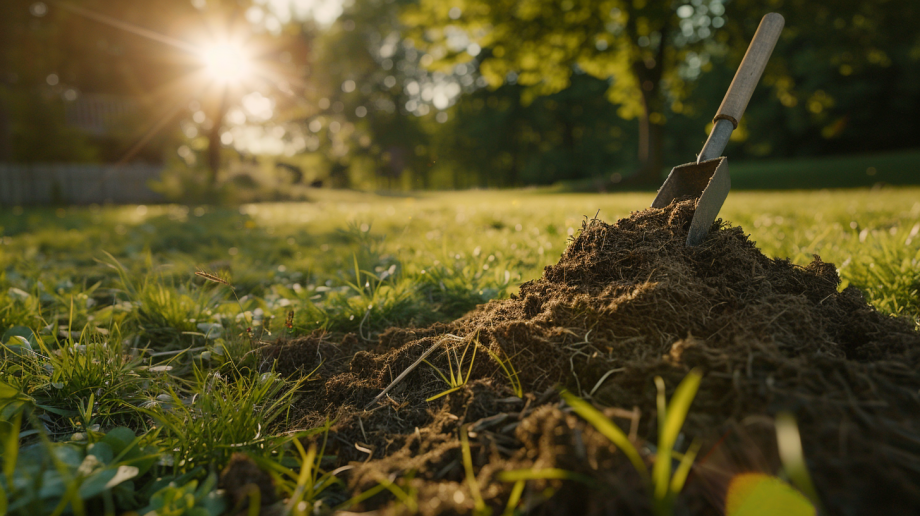
Using Peat Moss For Bare Spots In Lawn? (Go For It!)
Do you have those annoying bare spots in your lawn? You know the ones – they pop up here and there, making your grass look a bit patchy?
It’s a common problem that many of us face, and it can be pretty frustrating.
These bare patches don’t just look bad; they also invite weeds to move in and can lead to soil washing away. If you’re looking to identify the type of soil you have in the Richmond area we recommend Soils-Inc!
But don’t worry! There’s a natural fix that more and more gardeners are turning to: peat moss.
This stuff is pretty amazing for bringing those bare spots back to life!
In this post, I’ll go over everything about using peat moss for bare spots in lawn.
Can I Use Peat Moss For Bare Spots In Lawn?
Yes you can! Peat moss is great for fixing up those bare spots. It’s not just a quick cover-up; it actually helps create the perfect conditions for new grass to grow.
Peat moss has a bunch of qualities that make it really good for this job.
It helps seeds sprout, makes your soil better, and even protects the new grass as it grows.
That’s why so many gardeners reach for peat moss when they need to fix bare spots.
Also Read: Liquid or Granular Fertilizer
Let me explain some if its qualities in more detail:
Moisture Retention
One of the coolest things about peat moss is how it holds onto water. This is super important when you’re trying to grow new grass in bare spots.
Peat moss soaks up a lot of water and then slowly lets it out to the soil and seeds around it.
This means your new seeds will have water when they need it, even if it doesn’t rain for a while.
You won’t need to water as often, and your seeds will have all the moisture they need to sprout and grow into healthy grass.
Improves Soil Structure
Peat moss does more than just hold water; it actually makes your soil better overall.
When you mix peat moss into the bare spots of your lawn, it helps loosen up packed-down soil and improves how it’s structured.
This better structure lets air and water move through the soil more easily.
As a result, grass roots can grow better and deeper, getting more nutrients and water.
This leads to stronger, healthier grass that can better handle things like dry spells or people walking on it.
Improves Seed Contact
When you’re trying to grow new grass in bare spots, it’s really important for the seeds to touch the soil well.
Peat moss is great for this because it creates a perfect little bed for the seeds.
When you spread peat moss over your newly planted seeds, it forms a light layer that helps the seeds nestle right up against the soil underneath.
This close contact is key for the seeds to sprout because it lets them get the moisture and nutrients they need to start growing.
Seed Protection
Another great thing about using peat moss on bare spots is how it protects your grass seeds.
When you put a light layer of peat moss over your newly planted seeds, you’re basically giving them a protective blanket.
Also Read: Pet Friendly Ground Coverings for Your Yard
This keeps the seeds in place, so they don’t get washed away by rain or blown away by wind.
It also helps keep the temperature and moisture around the seeds just right, making a stable environment for them to sprout.
This protection gives your grass seeds the best chance to take root and grow into healthy plants.
How To Use Peat Moss For Bare Spots
Now that you know peat moss is great for bare spots in lawn, lets see how to use it:
#1 Prepare the Area
First things first, you need to get the area ready.
Start by clearing out any junk, dead grass, or weeds from the bare spot. Use a rake to get all this stuff out and to lightly scratch up the surface of the soil.
This scratching helps loosen up packed-down soil and makes a better place for seeds to sprout.
Take your time with this step – good prep work sets you up for success.
Try to loosen up about half an inch of soil across the whole bare area.
#2 Seed Application
Once you’ve got the area prepped, it’s time to plant your grass seeds.
Pick a type of grass seed that matches the rest of your lawn and grows well in your area. Spread the seeds evenly over the area you’ve prepared.
You want good coverage, but don’t go overboard.
Too many seeds fighting for space can lead to weak grass.
Use a seed spreader or just your hand for smaller areas, making sure to spread the seeds evenly across the whole bare spot.
#3 Add Peat Moss
Now for the key step: adding the peat moss.
Spread a thin, even layer of peat moss over the area where you just planted the seeds.
You don’t need a thick layer – about a quarter to half an inch is plenty. This thin layer is enough to hold moisture and protect the seeds without smothering them.
Gently rake the peat moss to spread it evenly and help it settle a bit into the soil.
#4 Watering
The last step is watering.
Give your newly seeded and peat moss-covered area a good, gentle watering. You want to wet the peat moss and the soil underneath without washing away the seeds.
Use a sprayer with a fine mist or a sprinkler on its gentlest setting.
Keep the area consistently moist (but not soaking wet) for the next few weeks. You might need to water lightly once or twice a day, depending on how hot and dry it is where you live.
Keeping things consistently moist is key to getting the seeds to sprout and the grass to start growing well.
Things To Keep In Mind When Using Peat Moss
Now there are some things you need to know about using peat moss:
Acidity
It’s good to know that peat moss is naturally a bit acidic. This isn’t usually a problem, but it can change how acidic your soil is.
Some types of grass like slightly acidic soil, while others prefer it more neutral.
If you’re worried about the acidity, you might want to test your soil before adding peat moss.
If your soil is already on the acidic side, you could add some lime to balance it out. Or, you could mix the peat moss with some compost to help make it less acidic.
It Can Dry Out
While peat moss is great at holding onto moisture, it can dry out in certain conditions, especially when it’s hot and sunny.
When peat moss gets completely dry, it can form a hard crust on top that’s tough for water to get through. This can stop moisture from reaching your grass seeds and young plants.
Also Read: Plants That Grow Great in Sandy Soil
To prevent this, keep a close eye on your newly seeded area, especially when it’s warm or windy.
Water as needed to keep the peat moss consistently moist until your grass is growing well.
Nutrient Content
Peat moss is great for improving how your soil holds water and how it’s structured, but it doesn’t provide much in the way of nutrients for your grass.
It doesn’t give them the essential nutrients they need to grow strong and healthy.
To fix this, you might want to mix a balanced, slow-release fertilizer into your peat moss before you spread it on the bare spots.
Or, you could plan to fertilize the seeded area once the grass has sprouted and started to grow.
This will make sure your new grass has all the nutrients it needs to grow thick and healthy.








